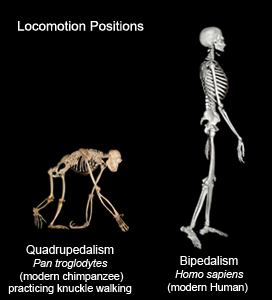
Bipedalism refers to locomoting (e.g., walking, jogging, running, etc.) on 2 legs. It is not uncommon to see animals standing or walking on 2 legs, but only a few animals practice bipedalism as their usual means of locomotion. Animals, including chimpanzees and gorillas, that assume bipedalism on a temporary basis in order to perform a particular function practice a form of locomotion called facultative bipedalism. For example, octopodes sometime walk bipedally in order to camouflage themselves from predators1. The octopus piles 6 of its 8 limbs on top of its head, assuming the shape of a drifting plant, and then uses the 2 remaining limbs to quite literally walk away. As for quadrupeds (animals that move on four limbs), it is not uncommon to see antelope standing on their 2 hind limbs while supporting themselves on their forelimbs when reaching for food in high branches. Chimpanzees have been documented walking on 2 legs in order to carry things with their hands.
move on four limbs), it is not uncommon to see antelope standing on their 2 hind limbs while supporting themselves on their forelimbs when reaching for food in high branches. Chimpanzees have been documented walking on 2 legs in order to carry things with their hands.
Habitual bipedalism, or obligate bipedalism, is rare. This is the form of bipedalism that is assumed as a regular (i.e., habitual) means of locomotion. Today, very few mammals (e.g., humans and kangaroos) demonstrate habitual bipedalism. However, many early hominins (i.e., a classification term that includes modern humans and all their bipedal fossil relatives) show a combination of primitive and novel adaptations that suggest these species utilized bipedalism but still engaged in arboreal behaviors.
eFossils is a collaborative website in which users can explore important fossil localities and browse the fossil digital library. If you have any problems using this site or have any other questions, please feel free to contact us.
Funding for eFossils was provided by the Longhorn Innovation Fund for Technology (LIFT) Award from the Research & Educational Technology Committee (R&E) of the IT governance structure at The University of Texas at Austin.
